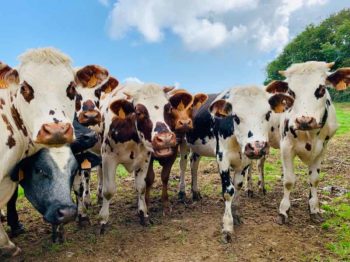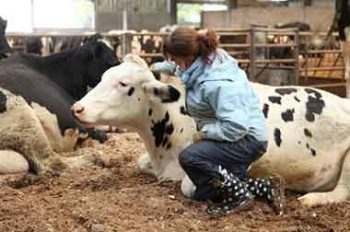26 Aug 2021
Helen Lambert MSc, BSc(Hons), MSB introduces sentience science, before discussing the important role vets play.

Figure 1. Cephalopods are the only invertebrates protected in research in the UK.
Today’s animal owners are more educated on the importance and extent of animal emotions than ever before. Therefore, their concerns for their animal’s health and well-being go beyond their physical health, as they understand the complexity of the animal mind, and recognise their ability to experience a wide range of conscious emotions. A growing body of scientific evidence documents the remarkable and diverse subjective experiences of animals. The science of animal sentience continues to develop new, accurate ways to help us understand how animals are feeling, giving us the ability to improve their welfare even more.
In animal welfare science, we are seeing an increasing focus and demand for concern with both positive and negative states in animals. Good animal welfare is not just about removing or minimising negative states and experiences, but should also be about providing the opportunity for animals to feel good, and to engage in behaviours that are pleasurable for them. This article introduces the field of animal sentience science and discusses the important role of the veterinarian.
The scientific literature has seen a recent boom in the number of publications focusing on the emotional and subjective lives of animals (Proctor et al, 2013). This growing field of research offers more insight into the minds of animals than ever before, enabling us to better care for the welfare of animals.
Animal sentience refers to the ability of animals to feel both positive and negative emotions and experiences, such as pain, fear, joy and pleasure (Broom, 2010; Proctor, 2012). The science of sentience is becoming far more mainstream with the increase in “popular science” books and documentaries on the subject. As a result, animal owners today are more attuned than ever to the emotional lives of their animals.
Evidence for animal sentience comes from neuroscience and animal behaviour (Boyle, 2009; Kirkwood, 2006; Proctor et al, 2013). In vertebrates it is clearer to see the neurological traits of sentience, as all vertebrate species have a CNS, and similar major structures and divisions in the brain (Butler, 2008). Furthermore, the limbic system, which is responsible for processing emotions, is also similar across all of the vertebrate species (Boyle, 2009).
In recent years, scientists have also found complex neurons, once believed to be unique to humans, in several species of cetaceans, primates and elephants (Damasio and Meyer, 2008; Hakeem et al, 2009; Hof and Gucht, 2007). For example, cortical spindle cells that are specialised in emotional processing have been found in humpback whales (Hof and Gucht, 2007). Whereas macaques have been found to possess mirror neurons that assist in empathic behaviour and learning (Damasio and Meyer, 2008).
In 2012, a group of globally renowned cognitive neuroscientists, neuropharmacologists, neurophysiologists, neuroanatomists, and computational neuroscientists came together at the University of Cambridge to reassess the neurobiological substrates of conscious experience and related behaviours in human and non-human animals.
The resulting Cambridge Declaration on Consciousness declared that the neocortex was not essential for the experience of emotional states. It stated that non-human animals – including all mammals and birds, and many other species, including octopuses – possess the neurological substrates required for generating consciousness (Cambridge Declaration on Consciousness, 2012).
They also commented on the evolving nature of the field, and stated that, with the continual emergence of new strategies and techniques, the data should be reassessed periodically.
Animal behaviour also tells us a great deal about the emotional capacity of animals, proving of particular use where the neurological evidence is lacking (Elwood, 2011). Invertebrates, for example, do not have the physical characteristics often thought to be responsible or required for sentient feeling (Boyle, 2009; Elwood et al, 2009; Sherwin, 2001). As a result, they are generally assumed to be incapable of experiencing pain and are treated very differently from their vertebrate counterparts (Mather, 2001).
For example, very little legislation exists protecting invertebrates around the world, which means that invertebrates can often be treated in ways that would be illegal and considered inhumane for vertebrates (Lewbart, 2012; Sherwin, 2001).
Scientific research into the subjective experiences of invertebrates is increasing, however, and the behaviour of a number of species has indicated that they are capable of conscious experience. Cephalopods have already been singled out for protection in legislation, and octopuses were named in the Cambridge Declaration of Consciousness as being capable of conscious experience. In the UK’s Animals (Scientific Procedures) Act (1986), cephalopods are offered the same level of protection as vertebrates (Figure 1).

Significant evidence also exists that decapod crustaceans, such as crabs and lobsters, are worthy of protection, too. For example, crabs and crayfish have been found to respond to painful stimuli by learning to avoid it (Kawai et al, 2004; Magee and Elwood, 2013). Glass prawns will perform pain behaviours such as rubbing (Barr et al, 2008) and autotomy (Elwood et al, 2009), and will respond to analgesics in the same way as vertebrates (Barr et al, 2008; Figure 2).
Behavioural studies have also provided insight into the subjective experiences of fish. Fish are often considered to be incapable of pain because they do not have the regions of the neocortex and mesocortex thought to be responsible for the conscious experience of pain in mammals (Rose, 2002; Rose et al, 2012). They were also notably omitted from the Cambridge Declaration on Consciousness.
However, a number of behavioural studies indicate that despite their neurological differences to mammals, the behaviour of fish provides strong evidence for the conscious experience of pain.
For instance, one study applied painful bee venom to the lips of rainbow trout (Oncorhynchus mykiss). This resulted in the fish losing their fear of novel objects, and caused them to rub their lips on the side of the tank and rock from side to side. These behaviours, and the noticeable drop in their attention levels, indicated that they were experiencing pain on a conscious level as opposed to nociception. Furthermore, when they were given analgesic morphine they ceased the behaviours and became fearful of novel objects again (Sneddon, 2003).
Pain and disease play a key role in an animal’s welfare, and if the animal is suffering from either then their welfare is compromised. Good animal welfare, however, is about more than just removing these factors. It is increasingly recognised that animals should lead a good life, one that is rich with positive experiences and emotions (Edgar et al, 2013; Green and Mellor, 2011; Yeates and Main, 2008).
The veterinary community plays a key role in educating owners and caregivers of this, and in ensuring that a patient’s physical and mental welfare is cared for. This is of particular relevance in industry; whether the animal is a research species, or used in agriculture, trade or entertainment.
Often, in such a case, the focus will be on minimising negative states brought about by the practices or procedures inflicted on the animal (Boissy et al, 2007). Beyond this, however, the quality of the animal’s life can be greatly improved by ensuring that its mental health is considered and provided for (Green and Mellor, 2011).
Environmental enrichment can greatly aid in this, as it can offer the animal opportunities to perform species-specific behaviours, some of which may elicit positive emotions (Meagher and Mason, 2012). Conscious efforts to allow for, and encourage, behaviours known to induce positive states such as play, suitable social interactions or grooming opportunities can be easy, yet effective ways to improve an animal’s welfare from satisfactory to good (Edgar et al, 2013).
This exciting area of science has many implications for how we treat animals and the policies that govern their care. The role of the veterinarian is vital in both ensuring the mental and physical welfare of animals, but also in educating owners and animal managers on their role in improving the health and emotional lives of the animals in their care.

As veterinarians you will be fully aware of your role to not only treat the animals you care for, but also to educate owners on what is best for the animals. Concern for the emotional element of an animal’s welfare is crucial in this, and can have considerable benefits to their health and welfare. Numerous links exist between the effects of poor mental well-being and physical health (Gregory, 2004).
Scientists are now also considering the effects of positive emotions on the physical health of animals (Boissy et al, 2007; Cabanac, 2005). This is a burgeoning area of research in humans, and research is exploring whether laughter and positive experiences can have a positive effect on physical health (Penson et al, 2005; Pressman and Cohen, 2005).
In cattle, it was found that positive treatment of heifers resulted in subsequent improved parlour behaviour and milk production (Breuer et al, 2003), and that farms where cows were called by name reported significantly higher milk yields than those where this was not the case (Bertenshaw and Rowlinson, 2009).
More research needs to be done to further explore these effects in animals, but the overwhelming evidence for the relationship between negative emotions and physical health gives a strong indication that a significant link will exist between positive emotions and health (Figure 3).
Veterinary procedures can sometimes be negatively perceived by the animals involved, whether it’s the result of handling by an unfamiliar person, fear from being socially isolated, or as a result of the pain experienced from the procedure (Grandin, 1997; Mellor and Stafford, 2002; Weiss and Pryce, 2004). Simple steps can be adopted to minimise the distress experienced by the animal.
In the case of domesticated animals, gentle tactile contact has been shown to be effective in reducing distress. For example, in cattle, sheep and horses, gentle stroking and calm voices have been shown to reduce cortisol levels, heart rate, and flight distances during both veterinary procedures and handling (Hama et al, 1996; Hemsworth and Barnett, 1989; Reefmann et al, 2009; Schmied et al, 2010; Schmied et al, 2008; Waiblinger et al, 2004; Windschnurer et al, 2009; Figure 4).

In addition, the presence of a familiar and positively perceived person can have significant positive effects on the emotional experience of the animal (Waiblinger et al, 2004). Where possible, social isolation should be minimised for social animals, as this has been shown repeatedly in a number of species to be extremely stressful (Reefmann et al, 2009; Reimert et al, 2012; Weiss and Pryce, 2004). Small measures such as these can have a considerable impact on the animals’ experience, and on their welfare. Furthermore, it can have positive effects on future interactions, and make procedures quicker and easier to perform.
Animal sentience is a fascinating and growing field of science, with increasing attention from both the scientific community and the public. As this field continues to evolve we will have even more tools and knowledge at our disposal to measure and assess the mental well-being and emotional experience of animals.
In the meantime, a strong need still exists to accommodate an animal’s feelings, and to strive to ensure that it experiences positive emotions and states in its life, while continuing to minimise negative ones. Doing so may lead to positive impacts on the animal’s physical health, ongoing human-animal interactions and productivity, and it will certainly improve its welfare.